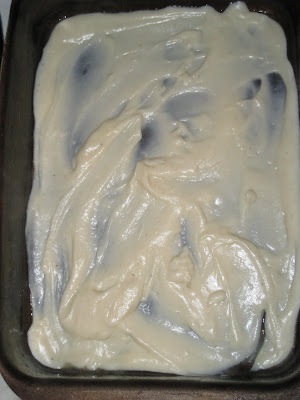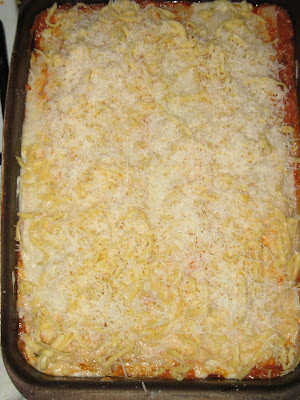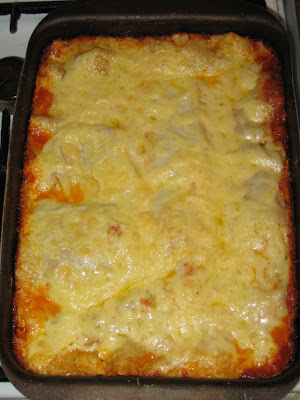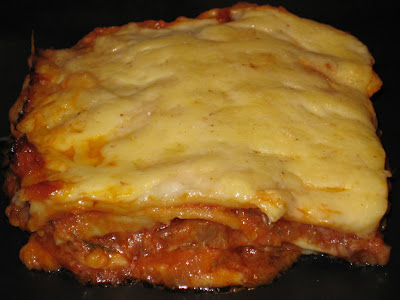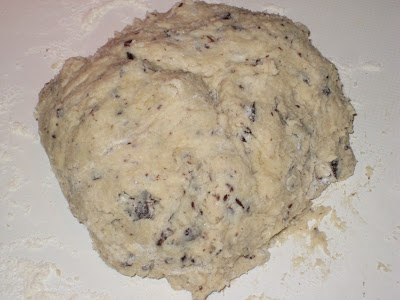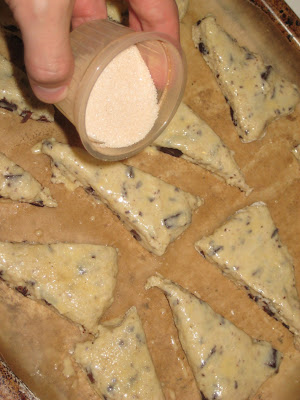I often have a funny relationship to my recipes. I try a recipe out and like it. Then what should I do next time; see if there's an even better recipe out there or use the same again? If it's good, then why change it? Lasagna was probably the second recipe I ever made after mastering boiling pasta and adding ketchup when I was a student. And ever since I've been making a basic lasagna which I thought was pretty damn good. That is, until I tried out this recipe. It all came from watching Heston Blumenthal making bolognese sauce in his Search for Perfection. And I thought, hey, the bolognese sauce is also the base of lasagna. And as I was going out of my way to make the sauce, why not make my own pasta as well. The result was, well, how can I put it, so good that it would be the only lasagna I ever made again if it wasn't so time consuming. So I admit, you need half a day to make it, and is it worth it? Yes, if you want to impress some dinner guests, but definitely not if it's just for a normal week day. But if you are only going to make one lasagna in your life, then this is it. And, finally, the sauce is brilliant in itself as bolognese, so give it a try.
Ingredients:Ragout:
3 carrots, shredded
2 celery stalks finely diced
2 onions, finely chopped
olive oil
1 star anise
1 glass of whitewine
250g finely chopped meat from an ox tail (see comment with picture)
250g finely chopped pork shoulder
50g finely chopped chicken liver
250ml milk
400ml water (maybe more)
Pasta:
5 dl flour
2 big eggs
1 tsp salt
1 tbsp olive oil
80ml water
Tomato sauce:
1 onion, chopped
3 cloves of finely chopped garlic
1 large can (850ml) of peeled tomatoes
1 tsp whole coriander seeds
3 cloves
1 star anise
2 tsp wostershire sauce
a little tabasco o chili sauce
1 tbsp ketchup
1 tbsp sherry vinegar
5-6 twigs of fresh thyme
1 bayleaf
5 drops of fish sauce
Small bunch of fresh parsley
1 tbsp butter
1/2 tbsp sherry vinegar
White sauce:
70g butter
70g flour
700ml cold milk
salt
Nutmeg
Shredded gouda cheese
Shredded parmesan cheese
 Fry the oinion in another pan (first sign that this is cumbersome). When the onion starts browning, break up the star anise and add it to the pan. Star anise has components that mix with the onion flavous and boost the umami flavours in meat (proteins).
Fry the oinion in another pan (first sign that this is cumbersome). When the onion starts browning, break up the star anise and add it to the pan. Star anise has components that mix with the onion flavous and boost the umami flavours in meat (proteins). When the onion is caramelized, remove the star anise and mix it with the celery in the pot where you are going to make the ragout. Deglaze the pans by adding half a cup of white wine to loosen all the stuck chunks of onion. Let it reduce a bit and pour it into the veggies.
When the onion is caramelized, remove the star anise and mix it with the celery in the pot where you are going to make the ragout. Deglaze the pans by adding half a cup of white wine to loosen all the stuck chunks of onion. Let it reduce a bit and pour it into the veggies. Time for the meat. The recipe calls for minced ox tail meat, which you won't find anywhere. The meat around the tail is hard to get off the bone, so the only way to do it is to buy the tail, patiently cut off the meat and chop it yourself. But the flavour is worth it. Don't throw away the bone, keep them or freeze them for making beef stock another day.
Time for the meat. The recipe calls for minced ox tail meat, which you won't find anywhere. The meat around the tail is hard to get off the bone, so the only way to do it is to buy the tail, patiently cut off the meat and chop it yourself. But the flavour is worth it. Don't throw away the bone, keep them or freeze them for making beef stock another day. Chop the pork shoulder finely. You can also put it in the food processor.
Chop the pork shoulder finely. You can also put it in the food processor. Heat up your pan to maximum, add some oil and fry the meat in one layer. If your pan isn't very big fry in two batches, otherwise the meat will cool off the pan, the meat will lose its juices and braise not fry. You want maximum heat until the meat is browned.
Heat up your pan to maximum, add some oil and fry the meat in one layer. If your pan isn't very big fry in two batches, otherwise the meat will cool off the pan, the meat will lose its juices and braise not fry. You want maximum heat until the meat is browned. Chop up the chicken liver finely and add to the browning meat at the end. Maybe you don't like liver, but you won't really able to taste it (as liver). But it does give a special tone to the flavour.
Chop up the chicken liver finely and add to the browning meat at the end. Maybe you don't like liver, but you won't really able to taste it (as liver). But it does give a special tone to the flavour. Add the meat to the vegetables. Deglaze the pan with some more white wine. Loosen all the chunks of stuck meat which is packed with flavour.
Add the meat to the vegetables. Deglaze the pan with some more white wine. Loosen all the chunks of stuck meat which is packed with flavour. Add the milk and the water. Let it simmer for 6 (SIX) hours! at low heat under lid. This seems like a lot, but first of all, the oxtail meat is quite tough and need plenty of cooking, and secondly, the liquid will reduce and concentrate all the good stuff. You need to stir now and then to make sure it doesn't catch and burn. It might also be necessary to add a bit more water if it starts getting too thick. Notice that you don't add salt.
Add the milk and the water. Let it simmer for 6 (SIX) hours! at low heat under lid. This seems like a lot, but first of all, the oxtail meat is quite tough and need plenty of cooking, and secondly, the liquid will reduce and concentrate all the good stuff. You need to stir now and then to make sure it doesn't catch and burn. It might also be necessary to add a bit more water if it starts getting too thick. Notice that you don't add salt.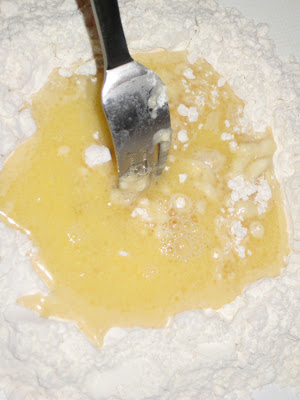 Sometimes during those six hours you will have plenty of time to make your own pasta. Start by putting the flour on the kitchen table, make a well in the middle and sprinkle the salt over it. Whisk the egg, water and oil in a cup. Pour it into the centre of the flour. Start mixing it slowly into the flour. If in doubt, click this link to see how it's done. Shape it into a ball of dough. If it's very wet, add some more flour, but be careful, you don't want it too dry or the pasta will break.
Sometimes during those six hours you will have plenty of time to make your own pasta. Start by putting the flour on the kitchen table, make a well in the middle and sprinkle the salt over it. Whisk the egg, water and oil in a cup. Pour it into the centre of the flour. Start mixing it slowly into the flour. If in doubt, click this link to see how it's done. Shape it into a ball of dough. If it's very wet, add some more flour, but be careful, you don't want it too dry or the pasta will break.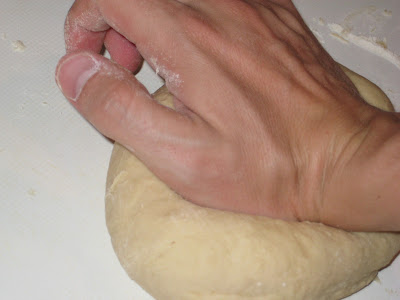 Knead the pasta dough for at least 10 minutes. Kneading is essential for ceatin elastic dough. Then wrap it in cling film and put it in the fridge for minimum 30 minutes. This will allow for the dough to develope.
Knead the pasta dough for at least 10 minutes. Kneading is essential for ceatin elastic dough. Then wrap it in cling film and put it in the fridge for minimum 30 minutes. This will allow for the dough to develope.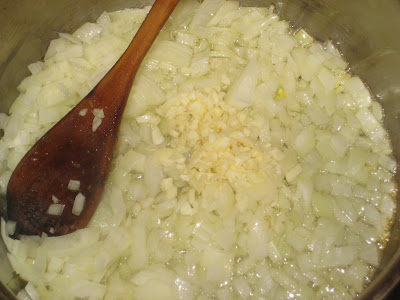 For making the tomato sauce, start out by frying the onion. When the onion is translucent, add the garlic and fry for a couple of minutes. Then add the finely chopped (or blended) tomatoes.
For making the tomato sauce, start out by frying the onion. When the onion is translucent, add the garlic and fry for a couple of minutes. Then add the finely chopped (or blended) tomatoes. Put the coriander, cloves and star anise in a thin piece of cloth. Tie it in like a small package, bang it once or twice to crush the spices a bit.
Put the coriander, cloves and star anise in a thin piece of cloth. Tie it in like a small package, bang it once or twice to crush the spices a bit. Throw it in the tomato sauce.
Throw it in the tomato sauce.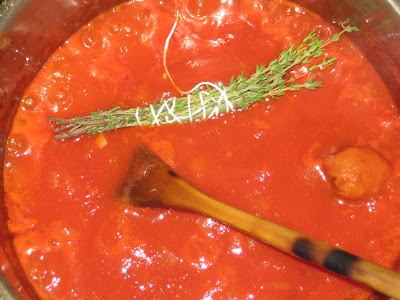 Add the wostershire sauce, ketchup, tabasco, vinegar, fish sauce and tie the thyme with the bayleaf and throw it in there too. Leave it to simmer without lid for 1 hour. Stir now and then so it doesn't catch.
Add the wostershire sauce, ketchup, tabasco, vinegar, fish sauce and tie the thyme with the bayleaf and throw it in there too. Leave it to simmer without lid for 1 hour. Stir now and then so it doesn't catch. Roll out the pasta either with a pasta machine or with a roling pin. You want it about 1 - 2 milimetre thick (pasta machine: 4). Cut it into long plates the lenght of your oven tray.
Roll out the pasta either with a pasta machine or with a roling pin. You want it about 1 - 2 milimetre thick (pasta machine: 4). Cut it into long plates the lenght of your oven tray. When the six hours have passed, add the meat ragout to the tomato sauce. Cook it together for 1 hour. Removethe thyme twigs, and the spice bag.
When the six hours have passed, add the meat ragout to the tomato sauce. Cook it together for 1 hour. Removethe thyme twigs, and the spice bag. At the end, add the butter, the chopped parsley and the vinegar. Taste for pepper. You shouldn't need salt, but if you think it needs, well, it's up to you.
At the end, add the butter, the chopped parsley and the vinegar. Taste for pepper. You shouldn't need salt, but if you think it needs, well, it's up to you. Make the white sauce (bechamel) by melting the butter at medium-low heat until it stops bubbling but before it starts burning.
Make the white sauce (bechamel) by melting the butter at medium-low heat until it stops bubbling but before it starts burning.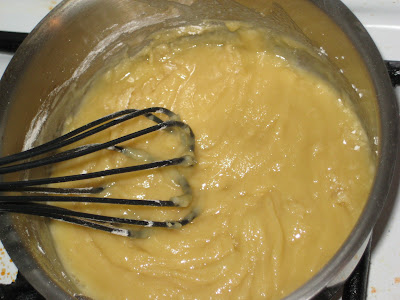 Add the flour and start whisking immediately. From here on you need to be whisking almost continually. Don't worry, it won't burn on you or lump up. Actually, you need to fry it for some time to cook the flour. After a few minutes it even starts getting more liquid. If you kept stirring you'd get a darker sauce which is needed in some recipes, but here go for about 4 minutes of stirring.
Add the flour and start whisking immediately. From here on you need to be whisking almost continually. Don't worry, it won't burn on you or lump up. Actually, you need to fry it for some time to cook the flour. After a few minutes it even starts getting more liquid. If you kept stirring you'd get a darker sauce which is needed in some recipes, but here go for about 4 minutes of stirring.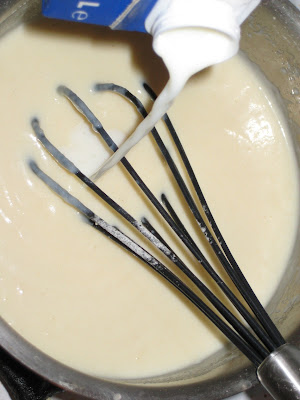 Add in your milk a bit at the time while whisking out the lumps. If you pour all in at one time you might risk biting flour balls later. Keep stirring until it thickens. The more you stir, the smoother the sauce.
Add in your milk a bit at the time while whisking out the lumps. If you pour all in at one time you might risk biting flour balls later. Keep stirring until it thickens. The more you stir, the smoother the sauce. When the sauce has thickened, add freshly grated nutmeg, taste with salt. You can add a pinch of cayenne as well, but as I've put chili in the meat I didn't do it this time.
When the sauce has thickened, add freshly grated nutmeg, taste with salt. You can add a pinch of cayenne as well, but as I've put chili in the meat I didn't do it this time.

